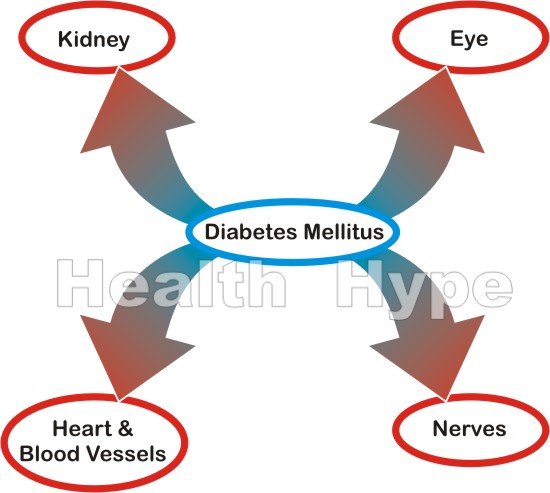Untreated Diabetes Mellitus Consequences and Symptoms
Diabetes mellitus, commonly referred to as sugar diabetes, is a growing problem globally largely associated with a more sedentary lifestyle and obesity. Despite it being one of the more common chronic conditions in most populations, there is still widespread ignorance about the serious nature of this disease and the consequences if the condition is left untreated. Since diabetes is largely asymptomatic in the early stages and eventually presents with several mild symptoms, there is a misconception that it is not a dangerous condition.
Diabetes mellitus can drastically reduce the quality of life if left untreated and eventually lead to life-threatening complications. The presence of diabetes mellitus even when well managed increases the risk of many other serious diseases. The most severe complications in diabetes is seen in long term cases that are poorly controlled but there are several diabetic emergencies that can suddenly arise which can be equally as dangerous even in a person who has been diabetic for just a short period of time.
What happens if diabetes mellitus is untreated?
It is important to first understand the disease mechanism in diabetes mellitus. The body has several ways of regulating the different levels of various substances in the body. This is largely controlled by the endocrine system – hormones that are secreted from different glands. One very important gland is the pancreas situated in the upper abdomen. While the pancreas produces and secretes digestive enzymes into the gut, it also has a crucial role to play in producing and secreting the hormones that control the blood sugar levels.
Insulin is one of the pancreatic hormones that regulates the blood sugar (glucose) levels. The bloodstream is being constantly monitored throughout the day and should the glucose levels rise too high, the pancreas releases insulin into the bloodstream. Insulin then acts on most cells in the body to reduce glucose levels in the body by :
- Stimulating cells to take in more glucose from the blood.
- Stimulating organs like the liver to convert glucose into its storage form known as glycogen.
- Inhibiting the liver from converting glycogen into glucose.
- Inhibiting the conversion of other substances like protein and fat into glucose.
Glucose is the simplest sugar that is used by the body to produce energy. The body is in a constant need of energy to fuel all the different process that is constantly occurring including basic life processes like breathing and pumping of blood by the heart. However, too much of glucose can be harmful to the body. It damages cells in the body in various ways and by doing so it leads to several other diseases in the long term or increases the risk of developing certain diseases.
It is therefore the responsibility of organs like the pancreas to maintain the balance of glucose available in the bloodstream. However, in diabetes mellitus the availability or response to insulin is compromised. This means that pancreas is either not producing enough insulin (insulin deficiency) or that all the cells in the body are not responding as it normally should to insulin (insulin resistance). Eventually the blood glucose levels are at a higher level than is the norm (hyperglycemia) and damages different parts of the body over months and years.
The glucose levels are not static. It rises after eating and drops when a person has not eaten for a while or is sleeping. A healthy regulation system will still maintain the blood glucose level within a normal range, whether glucose has to be pushed out of the bloodstream or recruited from the body’s stores – glycogen or fat. Should medication not be commenced in diabetes mellitus or used as prescribed, and if a person does not undertake dietary changes and start exercising, the blood glucose levels are out of control. It tends to remain high most of the time with episodes of very low blood glucose levels (hypoglycemia). Both hyperglycemia and hypoglycemia have serious consequences and can lead to life-threatening complications in the short and long term.
Effects of Untreated Diabetes Mellitus
Complications are the consequences of a disease that is either progressive, left untreated or poorly managed or has existed for a very long period of time. Therefore the effects of untreated diabetes mellitus is actually the complications that arise, usually in the long term. Even a person who has well managed diabetes mellitus is at risk of developing these complications. Untreated cases are virtually guaranteed of developing complications sooner.
The complications of diabetes mellitus does not occur overnight – it develops gradually over years and decades. However, severe hyperglycemia (high blood glucose levels) or hypoglycemia (low blood glucose levels) has immediate effects known as diabetic emergencies. It can develop within minutes or hours and be life threatening. However, these emergencies are more likely to arise in a person with poorly managed diabetes mellitus or with incorrect use of diabetes medication.
Over time various parts of the body are affected to different degrees. The onset of these conditions is largely individualistic meaning that one diabetic may experience certain complications sooner compared to another diabetic. The main organs and structures that are affected are the eyes, nerves, kidneys, blood vessels and heart.
Nerves
Diabetes mellitus can lead to nerve dysfunction and damage which is known as diabetic neuropathy.. This may be caused by the narrowing of blood vessels supplying the nerve cells with oxygen and nutrient rich blood. High quantities of glucose within the nerve cells affects the normal processes responsible for nerve function.
Heart and Blood Vessels
Diabetes mellitus contributes to high blood pressure and hyperlipidemia (increased blood fats) which damages the walls of the blood vessels. It leads to plaques forming in the blood vessel wall (atherosclerosis) and increases the risk of clots forming in the vessels. This can progress to a stroke or heart attack (myocardial infarction) as the blood supply to the brain and heart is compromised respectively. The narrowed arteries and weakened veins especially to the legs leads to sluggish circulation with a host of problems that subsequently develops in the legs and feet.
Kidneys
Kidney dysfunction arises as the tiny blood vessels which carries blood to be filtered is damaged and parts of the filtration membranes thicken. This is known as diabetic nephropathy. The impairment of kidney dysfunction gradually progresses to end-stage renal disease.
Eyes
Vision problems in diabetes mellitus arises for various reasons. It is a consequence of the narrowing of blood vessels supplying blood to the eye (diabetic retinopathy), damage of the nerve of the eye (diabetic neuropathy) and/or clouding of the lens of the eye (cataract).
Legs and Feet
The impaired blood flow and nerve damage associated with diabetes mellitus, as discussed above, impacts the most on the lower limbs. This causes a host of problems in the foot in particular and is therefore known as diabetic foot. Injury to the foot is often the trigger event that then progresses to more severe complications as a result of poor wound healing and weakened immune activity.
Pregnancy
Most cases of gestational diabetes (pregnancy diabetes) are mild and medication is not necessary. Dietary changes and moderate exercise may be sufficient to manage the diabetes which often resolves after childbirth. Medication is necessary in severe cases. Gestational diabetes has an effect on both mother and child. This includes :
- Heavier birth weight.
- Larger size of the baby at birth.
- Hypoglycemia in the newborn immediately after birth.
- Risk of developing type 2 diabetes later in life both for mother and child.
- Neonatal jaundice.
- Respiratory distress syndrome (baby).
- Preeclampsia (mother).
Symptoms of Untreated Diabetes Mellitus
The signs and symptoms of untreated diabetes mellitus or poorly managed diabetes mellitus depends on the conditions that arise. Firstly the symptoms of diabetes mellitus itself worsens so it is important to be familiar with these signs and symptoms. It includes :
- Frequent urination
- Excessive thirst
- Increased appetite
- Dry mouth
- Unexplained weight loss
- Fatigue
- Headaches
- Itchy skin
- Repeated infections
Some of the symptoms can be attributed to diabetic complications but cannot be easily differentiated from the clinical presentation of diabetes mellitus itself. Symptoms of complications includes :
- Vision is blurred, hazy or dim.
- High blood pressure.
- Poor wound healing.
- Numbness, tingling and pain particularly in the legs.
- Ulcers on the leg
- Reduced urination or no urine output
- Muscle weakness
- Nausea and vomiting
- Personality changes
- Swelling of the legs and feet







